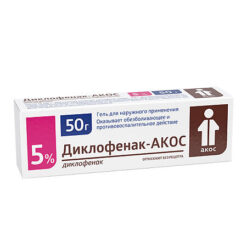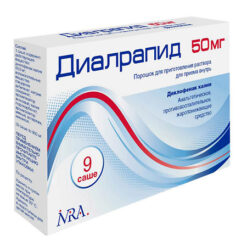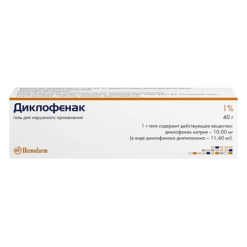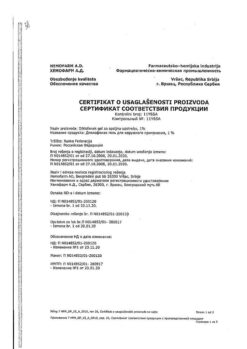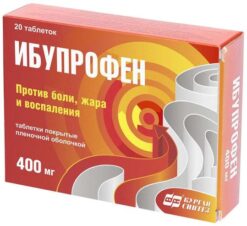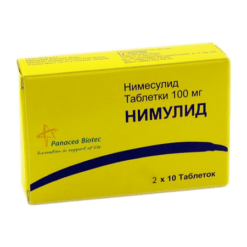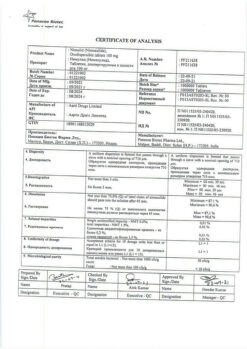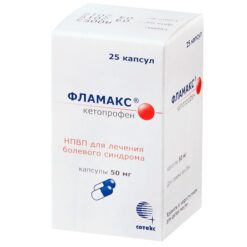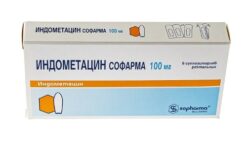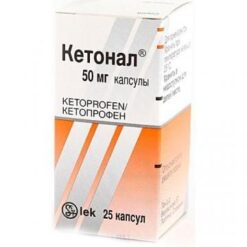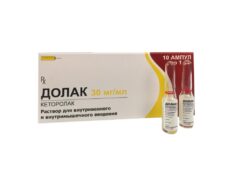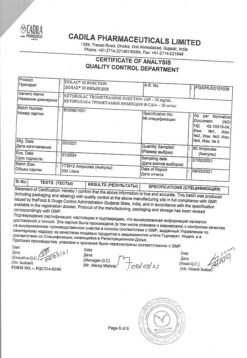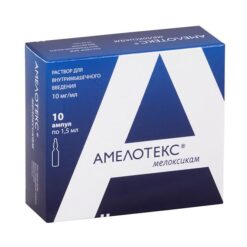No products in the cart.
Diclofenac Reneval, 50 mg 20 pcs
€4.24 €3.04
Description
Pharmacotherapeutic group: Non-steroidal anti-inflammatory drug (NSAID).
ATX code: M01AB05
Pharmacological properties.
Pharmacodynamics
Diclofenac Reneval contains diclofenac sodium, a substance of non-steroidal structure which has a pronounced anti-inflammatory, analgesic and antipyretic effect. The main mechanism of action of diclofenac, established in studies, is considered to be inhibition of prostaglandin biosynthesis. Prostaglandins play an important role in the genesis of inflammation, pain and fever.
In vitro diclofenac sodium, in concentrations equivalent to those achieved when used in humans, does not inhibit cartilage proteoglycan biosynthesis.
In rheumatic diseases, the anti-inflammatory and analgesic properties of the drug provide a clinical effect characterized by a significant reduction in the severity of such manifestations as pain at rest and on movement, morning stiffness and joint swelling, as well as improvement of functional status.
In posttraumatic and postoperative inflammatory phenomena diclofenac quickly relieves pain (both at rest and on the move), reduces inflammatory edema and swelling of the postoperative wound.
A pronounced analgesic effect in moderate to severe pain of non-rheumatic origin was noted during application of the drug. It is also found that diclofenac is able to reduce pain sensations and decrease blood loss in primary dysmenorrhea.
Pharmacokinetics
absorption
. After oral administration of enteric film-coated tablets, diclofenac is completely absorbed in the intestine. Absorption is rapid, but its onset may be delayed due to the presence of an enteric coating on the tablet. After a single use of 50 mg of the drug, maximum plasma concentration (Cmax) is on average 2 hours later and is 1.5 µg/ml
(5 µmol/L). The amount of absorbed active substance is in direct relation to the size of the dose of the drug.
If the tablet is taken during or after a meal, its passage through the stomach is slower (compared to that on an empty stomach), but the amount of diclofenac absorbed does not change.
Because about half of diclofenac is metabolized during the first passage through the liver (“first pass effect”), the area under the
“concentration-time” curve (AUC) in case of oral or rectal administration is almost 2 times less than in case of parenteral administration of the drug in the equivalent dose.
The pharmacokinetic parameters do not change after repeated doses of the drug. There is no cumulation when following the recommended dosing regimen of the drug.
Distribution
The binding to serum proteins is 99.7%, predominantly to albumin (99.4%). Apparent volume of distribution is 0.12-0.17 l/kg.
Diclofenac penetrates into the synovial fluid, where its maximum concentration is reached 2-4 hours later than in the blood plasma. The elimination half-life from synovial fluid is 3-6 hours. Two hours after reaching the maximum concentration in plasma, the concentration of diclofenac in synovial fluid is higher than in plasma, and its values remain higher for up to 12 hours.
Diclofenac was detected in low concentrations (100 ng/ml) in the breast milk of one nursing mother. The estimated amount of diclofenac ingested with breast milk was equivalent to 0.03 mg/kg/day.
Biotransformation/Metabolism
. Diclofenac is metabolized partly by glucuronidation of the unchanged molecule, but mainly by single and multiple hydroxylation and methoxylation, resulting in several phenolic metabolites (3¢-hydroxy-, 4¢-hydroxy-, 5¢-hydroxy-, 4¢,5¢-dihydroxy- and
3¢-hydroxy-4¢-methoxydiclofenac), most of which are converted to glucuronide conjugates. The two phenolic metabolites are biologically active, but to a much lesser extent than diclofenac.
Elimation
The total systemic plasma clearance of diclofenac is 263 ± 56 ml/min. The terminal elimination half-life is 1-2 hours. The half-life of
the 4 metabolites, including the two pharmacologically active ones, is also short and is 1-3 hours. One of the metabolites, 3¢-hydroxy-, 4¢-methoxy-diclofenac, has a longer half-life, but this metabolite is completely inactive.
About 60% of the dose is excreted by the kidneys as glucuron conjugates of the unchanged active substance, and as metabolites, most of which are also glucuron conjugates. Less than
1% of diclofenac is excreted unchanged. The remainder of the dose is excreted as metabolites in the bile.
The concentration of the active substance in plasma is linearly dependent on the dose taken.
Pharmacokinetics in special patient groups
The absorption, metabolism and excretion of diclofenac are independent of age. In children plasma concentrations of diclofenac when using equivalent doses of the drug (mg/kg body weight) are similar to those in adults. But in some elderly patients after 15-min intravenous infusion an increase of diclofenac plasma concentration by 50% was noted in comparison with such index in healthy volunteers of younger age.
In patients with impaired renal function no cumulation of unchanged active substance is observed when following the recommended dosing regimen. When creatinine clearance is less than 10 ml/min estimated equilibrium concentrations of diclofenac hydroxymetabolites are approximately 4 times higher than in healthy volunteers, and the metabolites are excreted exclusively with bile.
In patients with chronic hepatitis or compensated cirrhosis the pharmacokinetics of diclofenac are similar to those of patients with preserved liver function.
Indications
Indications
Isolated fever is not an indication for the use of the drug.
The drug is intended for symptomatic therapy and to reduce pain and inflammation at the time of use; it has no effect on disease progression.
Active ingredient
Active ingredient
Composition
Composition
One tablet contains:
Active ingredient:
Diclofenac sodium 25,000 mg 50,000 mg
Excipients: Corn starch, sodium carboxymethyl starch, lactose monohydrate, microcrystalline cellulose, colloidal silica (aerosil), povidone K 30, magnesium stearate
Shell composition (50 mg dosage):
Shell 1: OPADRY® COMPLETE FILM COATING SYSTEM 03F230051 ORANGE [hypromellose (hydroxypropyl methylcellulose), talc, iron oxide yellow dye (E172), titanium dioxide, macrogol (polyethylene glycol), iron oxide red dye (E172)] Shell 2: ACRYL-EZE® AQUEOUS ACRYLIC ENTERIC SYSTEM 93F19255 CLEAR [methacrylic acid and ethylacrylate copolymer [1:1], talc, macrogol (polyethylene glycol), colloidal silica (aerosil), sodium hydrocarbonate, sodium lauryl sulfate], emulsion 30% simethicone
How to take, the dosage
How to take, the dosage
Ingestion.
The dose of the drug is adjusted individually, and in order to reduce the risk of side effects, it is recommended to use the lowest effective dose, with the shortest possible treatment period according to the purpose of treatment and the patient’s condition.
The tablets should be swallowed whole with plenty of water, preferably before meals. The pills should not be divided or chewed.
Adults.The recommended starting dose is 100-150 mg/day. In relatively mild cases of the disease and for long-term therapy, 75-100 mg/day may be sufficient. The daily dose should be divided into several doses. For relief of nighttime pain or morning stiffness, in addition to taking the drug during the day, diclofenac is used in the form of rectal suppositories before bedtime from other manufacturers; the total daily dose should not exceed 150 mg.
In primary dysmenorrhea the daily dose is adjusted individually; usually it is 50-150 mg. The initial dose should be 50-100 mg; if necessary it may be increased to 150 mg/day over several menstrual cycles. The drug should be started at the appearance of the first symptoms. Depending on the dynamics of clinical symptoms, treatment may be continued for several days.
In children aged 6 years and older diclofenac in the form of film-coated, enteric-soluble tablets 25 mg at the rate of 0.5-2 mg/kg of body weight per day (the daily dose should be divided into 2-3 single doses, depending on the severity of the disease manifestations).
For the treatment of rheumatoid arthritis the daily dose can be increased to a maximum of 3 mg/kg (in several doses). The maximum daily dose should not exceed
150 mg.
In children under 6 years of age diclofenac should be used in another dosage form.
Elderly patients (≥65 years)
The initial dose adjustment in patients aged 65 years and older is generally not necessary. However, for general medical reasons, caution should be exercised in frail elderly patients or patients of low body weight.
Patients with cardiovascular disease or high cardiovascular risk
. Particular caution should be used in patients with cardiovascular disease or high risk of cardiovascular disease
. If prolonged therapy (more than 4 weeks) in such patients is necessary, the daily dose of the drug should not exceed 100 mg.
Patients with impaired renal function
There is no data on the need to adjust the dose when using the drug in patients with impaired renal function due to the lack of safety studies of the drug in patients in this category. Caution should be exercised when using the drug in patients with impaired renal function.
The drug is contraindicated in patients with renal impairment (FFR less than
15 ml/min/1.73 m2) (see section “Contraindications”).
Patients with hepatic impairment
There is no data on the need to adjust the dose when using the drug in patients with mild to moderate hepatic impairment due to the lack of safety studies of the drug in this category of patients.
The use of the drug is contraindicated in patients with severe hepatic impairment (see “Contraindications”).
Interaction
Interaction
Interactions identified
em>Inhibitors of isoenzyme CYP2C9. Caution should be exercised when diclofenac and CYP2C9 isoenzyme inhibitors
(such as voriconazole) are used simultaneously due to possible increase in diclofenac serum concentration and exposure.
Lithium, digoxin. Diclofenac may increase lithium content and plasma concentration of digoxin. Monitoring of lithium and digoxin serum concentrations is recommended.
Diuretic and hypotensive agents. When used concomitantly with diuretics and hypotensive drugs (e.g., beta-adrenoblockers, angiotensin-converting enzyme inhibitors – ACE) diclofenac may reduce their hypotensive effect. In relation to the above mentioned, in patients, especially elderly patients, when concomitant use of diclofenac and diuretics or hypotensive agents should be regularly measured and the renal function and hydration rate should be monitored (due to increased risk of nephrotoxicity).
Cyclosporine and tacrolimus. The effect of diclofenac on renal prostaglandin activity may increase the nephrotoxicity of cyclosporine and tacrolimus. Due to the above, the dose of diclofenac in patients receiving cyclosporine or tacrolimus should be lower than in patients not receiving these drugs.
Drugs that may cause hyperglycemia. Simultaneous use of diclofenac with potassium-saving diuretics, cyclosporine, tacrolimus and trimethoprim may increase plasma potassium
(in case of such concomitant use this index should be frequently controlled).
Antibacterials – quinolone derivatives. There have been isolated reports of seizures in patients receiving quinolone derivatives and diclofenac concomitantly.
Predicted interactions
Drugs and glucocorticosteroids. Concurrent systemic use of diclofenac and other NSAID systems or glucocorticosteroids may increase the incidence of NTs (particularly GI).
Anticoagulants and antiaggregants. We should use diclofenac with the drugs of these groups with caution because of the risk of bleeding. In spite of the fact that in clinical trials it has not been established the effect of diclofenac on anticoagulants effect, there are separate reports about increase of bleeding risk in patients using this combination of drugs. Patients receiving concomitant treatment with these drugs should be closely monitored.
Selective serotonin reuptake inhibitors. Simultaneous use of diclofenac with selective serotonin reuptake inhibitors increases the risk of gastrointestinal bleeding.
Hypoglycemic drugs. In clinical trials it has been established that simultaneous use of diclofenac and hypoglycemic drugs is possible, and the effectiveness of the latter does not change. However, there are some reports about the development of both hypoglycemia and hyperglycemia in such cases, which required changing the dose of hypoglycemic drugs against the background of diclofenac use. Therefore, it is recommended to monitor blood glucose concentrations during concomitant use of diclofenac and hypoglycemic drugs.
There have been isolated reports of metabolic acidosis when diclofenac is used concomitantly with metformin, especially in patients with impaired renal function.
Metotrexate. Care should be taken when diclofenac is used less than 24 hours before or 24 hours after methotrexate administration, because in these cases the blood concentration of methotrexate may increase and its toxic effects may be stronger.
Phenytoin. Phenytoin and diclofenac should be used concomitantly with plasma concentrations of phenytoin due to possible increase of its systemic effect.
Inductors of isoenzyme CYP2C9. Caution should be exercised when diclofenac is used concomitantly with CYP2C9 isoenzyme inducers (such as rifampicin), as this may result in a significant decrease in plasma concentration of diclofenac and decreased exposure.
Special Instructions
Special Instructions
Gastrointestinal damage
When using diclofenac, as well as other NSAIDs, events such as bleeding or ulceration/perforation of the GI tract have been reported, in some cases with fatal outcome. These events can occur at any time during the use of these drugs with or without previous symptoms or a history of serious gastrointestinal disease. In elderly patients, such complications may have serious consequences. If patients receiving diclofenac develop bleeding or gastrointestinal ulcers, the drug should be discontinued.
To reduce the risk of gastrointestinal toxicity in patients with gastrointestinal ulcers, especially those complicated by bleeding or a history of perforation, and in elderly patients, the drug should be used in the lowest effective dose.
In patients at increased risk of gastrointestinal complications, as well as in patients receiving therapy with low doses of acetylsalicylic acid, gastroprotective agents (proton pump inhibitors or misoprostol) or other drugs should be used during therapy with the drug to reduce the risk of adverse effects on the GIT.
Patients with a history of gastrointestinal damage, especially the elderly, should inform their physician of any abdominal symptoms.
Patients with bronchial asthma
. Bronchial asthma exacerbation (NSAID intolerance/bronchial asthma triggered by taking NSAIDs), Quincke’s edema, and urticaria are most commonly reported in patients with bronchial asthma, seasonal allergic rhinitis, nasal polyps, chronic obstructive pulmonary disease, or chronic infectious airway disease (especially those associated with allergic rhinitis-like symptoms). In this group of patients, as well as in patients with allergies to other drugs (skin rash and itching or urticaria) special caution should be exercised when using diclofenac (readiness for resuscitation measures).
Skin reactions
Serious dermatological reactions such as exfoliative dermatitis, Stevens-Johnson syndrome, toxic epidermal necrolysis, in some cases with fatal outcome, during diclofenac use were very rarely observed. The greatest risk and incidence of severe dermatological reactions were observed in the first month of treatment with diclofenac. If the patient receiving diclofenac develops the first signs of skin rash, lesions of mucous membranes or other symptoms of hypersensitivity the drug should be discontinued.
In rare cases when using diclofenac, as well as other NSAIDs, anaphylactic/anaphylactoid reactions may develop in patients who have not previously received diclofenac.
Impacts on the liver
As during the use of diclofenac increased activity of one or more “liver” enzymes may be noted, during long-term therapy with the drug as a precautionary measure, control of liver function is indicated. In case of preservation and progression of liver function disorders or signs of liver disease or other symptoms (such as eosinophilia, rash and the like), the drug should be stopped. It should be noted that hepatitis with diclofenac may develop without prodromal signs.
Impacts on the kidneys
. During the therapy with diclofenac it is recommended to monitor renal function in patients with hypertension, heart or renal function disorders, elderly patients, patients receiving diuretics or other drugs affecting renal function, as well as in patients with significant reduction of extracellular fluid volume of any etiology, for example, before and after massive surgical interventions. After discontinuation of therapy by the drug the normalization of renal function parameters to initial values is usually observed.
Influence on the cardiovascular system
. Therapy with NSAIDs, including diclofenac, especially long-term and high-dose therapy, may be associated with a small increase in the risk of serious cardiovascular thrombotic complications
(including myocardial infarction and stroke).
In patients with cardiovascular diseases and high risk of cardiovascular diseases (e.g., arterial hypertension, hyperlipidemia, diabetes, smoking) the drug should be used with extreme caution, in the lowest effective dose with the shortest possible duration of treatment because the risk of thrombotic complications increases with increasing dose and duration of treatment. At prolonged therapy (more than 4 weeks) daily dose of diclofenac in such patients should not exceed
100 mg. The effectiveness of treatment and the patient’s need for symptomatic therapy should be periodically evaluated, especially in cases when its duration is more than 4 weeks. If the first symptoms of thrombotic disorders (e.g., chest pain, shortness of breath, weakness, speech disorders) appear, the patient should seek medical attention immediately.
Influence on the hematopoietic system
Diclofenac may temporarily inhibit platelet aggregation; therefore, in patients with hemostasis disorders, careful monitoring of relevant laboratory parameters is necessary. During long-term use of diclofenac it is recommended to perform regular clinical peripheral blood tests.
Masking signs of an infectious process
The anti-inflammatory effects of diclofenac may complicate the diagnosis of infectious processes.
Combined use with other NSAIDs
Diclofenac should not be used with other NSAIDs, including selective cyclooxygenase-2 inhibitors (COX-2) because of the risk of NS.
Influence on driving, operating machinery
Patients who experience visual disturbances, dizziness, drowsiness, vertigo or other central nervous system disorders while using diclofenac should not drive vehicles or operate machinery.
Synopsis
Synopsis
Contraindications
Contraindications
Side effects
Side effects
The following are the adverse events (AEs) that have been identified in clinical trials as well as in the use of diclofenac in clinical practice. The following criteria were used to assess the frequency of NIs:
“frequent” (≥ 1/100, < 1/10); “infrequent” (≥ 1/1000, < 1/100); “rare” (≥ 1/10000, < 1/1000); “very rare” (< 1/10000). The NUIs are grouped according to the system-organ class of the MedDRA Medical Regulatory Dictionary; within each class, the NUIs are listed in decreasing order of frequency of occurrence; within each group, allocated by frequency of occurrence, the NUIs are categorized in decreasing order of importance.
Disorders of the blood and lymphatic system: very rarely, thrombocytopenia, leukopenia, hemolytic anemia, aplastic anemia, agranulocytosis.
Disorders of the immune system: very rarely – hypersensitivity, anaphylactic/anaphylactoid reactions, including decreased blood pressure (BP) and shock; very rarely – angioedema (including facial edema).
Mental disorders: very rarely – disorientation, depression, insomnia, nightmares, irritability, mental disorders.
Nervous system disorders: frequently – headache, dizziness;
rarely – drowsiness; very rarely – sensory disorders, including paresthesias, memory disorders, tremors, seizures, anxiety, acute cerebral circulation disorders, aseptic meningitis.
Visual disorders: very rare – visual disturbances (blurred vision), diplopia.
Hearing organ and labyrinth disorders:often – vertigo; very rarely – hearing disorders, tinnitus.
Cardiac disorders: infrequent – myocardial infarction, heart failure, palpitations, chest pain.
Vascular disorders:very rarely – increased BP, vasculitis.
Disorders of the respiratory system, thoracic and mediastinal organs: rarely – bronchial asthma (including dyspnea); very rarely – pneumonitis.
Disorders of the gastrointestinal tract: often – abdominal pain, nausea, vomiting, diarrhea, dyspepsia, flatulence, decreased appetite; rarely – gastritis, gastrointestinal bleeding, vomiting blood, melena, diarrhea with blood, stomach and intestinal ulcers (with or without bleeding, stenosis or perforation, with possible development of peritonitis); very rarely – stomatitis, glossitis, esophageal damage, occurrence of diaphragm-like strictures in the intestine, colitis (nonspecific hemorrhagic colitis, ischemic colitis, exacerbation of ulcerative colitis or Crohn’s disease), constipation, pancreatitis.
Hepatic and biliary tract disorders:often – increased plasma aminotransferase activity; rarely – hepatitis; jaundice, liver function disorders; very rarely – fulminant hepatitis, liver necrosis, liver failure.
Dermatological and subcutaneous tissue disorders: frequent – skin rash;
rare – urticaria; very rare – bullous dermatitis, eczema, erythema, erythema multiforme, Stevens-Johnson syndrome, Lyell syndrome (toxic epidermal necrolysis), exfoliative dermatitis, itching, alopecia, photosensitivity reactions, purpura, Schoenlein-Henoch purpura.
Renal and urinary tract disorders: very rarely – acute kidney injury (acute renal failure), hematuria, proteinuria, tubulointerstitial nephritis, nephrotic syndrome, papillary necrosis.
General disorders and disorders at the site of administration: not infrequently, edema.
Disorders of the cardiovascular system: Data from clinical studies indicate a slight increase in the risk of cardiovascular thrombotic complications (e.g., myocardial infarction), especially with long-term use of diclofenac at high doses (daily dose over 150 mg).
Visual disturbances: Visual disturbances, such as visual disturbances, blurred vision, or diplopia, appear to be class effects of NSAIDs and are reversible after discontinuation. A possible mechanism for the development of such disorders is the inhibition of the synthesis of prostaglandins and other related substances, which alters the regulation of blood flow in the retina, which manifests as potential visual impairment. If these symptoms develop with diclofenac therapy, ophthalmologic evaluation should be considered to exclude any other cause.
It is important to report the development of adverse reactions to ensure continuous monitoring of the benefit-risk ratio of the drug. If any of the side effects listed in the instructions worsen, or if you notice any other side effects not listed in the instructions, tell your doctor. Healthcare professionals report any adverse reactions to the medicine through the national adverse reaction reporting systems.
Overdose
Overdose
Symptoms: vomiting, gastrointestinal bleeding, diarrhea, dizziness, tinnitus, seizures. In case of significant poisoning, acute renal failure and liver damage may develop.
treatment: supportive and symptomatic treatment is indicated for complications such as decreased BP, renal failure, seizures, GI disorders and respiratory depression. Forced diuresis, hemodialysis or hemoperfusion for excretion of NSAIDs, including diclofenac, from the body are ineffective, as active substances of these drugs are largely bound to plasma proteins and undergo intensive metabolism.
In case of life-threatening overdose when taking the drug orally, gastric lavage should be performed and activated charcoal prescribed to prevent diclofenac absorption as soon as possible.
Pregnancy use
Pregnancy use
Pregnancy
There is insufficient data on the safety of diclofenac use in pregnant women; therefore, diclofenac should be used in I and II trimesters of pregnancy only when the expected benefits to the mother exceed the potential risk to the fetus. Diclofenac, as well as other NSAIDs (inhibitors of prostaglandin synthesis) is contraindicated in the last 3 months of pregnancy (inhibition of uterine contractility, impaired renal function in the fetus with subsequent oligohydroamnios and/or premature closure of the fetal arterial duct is possible).
Breast-feeding period
While diclofenac, like other NSAIDs, penetrates into the breast milk in small amounts, the drug should not be used during breast-feeding to avoid adverse effects on the baby. If it is necessary to use the drug in a woman during this period, breastfeeding should be stopped.
Fertility
Because diclofenac, like other NSAIDs, can have adverse effects on fertility, women who are planning to become pregnant are not recommended to take the drug.
In patients who are being evaluated and treated for infertility, the drug should be stopped.
Similarities
Similarities
Additional information
| Shelf life | 3 years. Do not use after the expiration date. |
|---|---|
| Conditions of storage | In the original package (in a box in a package) at a temperature not exceeding 30 ºC. Keep out of reach of children. |
| Manufacturer | Update PFC AO, Russia |
| Medication form | enteric soluble tablets |
| Brand | Update PFC AO |
Other forms…
Related products
Buy Diclofenac Reneval, 50 mg 20 pcs with delivery to USA, UK, Europe and over 120 other countries.



